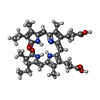+Search query
-Structure paper
| Title | Characterization of red-shifted phycobilisomes isolated from the chlorophyll f-containing cyanobacterium Halomicronema hongdechloris. |
|---|---|
| Journal, issue, pages | Biochim Biophys Acta, Vol. 1857, Issue 1, Page 107-114, Year 2016 |
| Publish date | Oct 26, 2015 |
 Authors Authors | Yaqiong Li / Yuankui Lin / Christopher J Garvey / Debra Birch / Robert W Corkery / Patrick C Loughlin / Hugo Scheer / Robert D Willows / Min Chen /    |
| PubMed Abstract | Phycobilisomes are the main light-harvesting protein complexes in cyanobacteria and some algae. It is commonly accepted that these complexes only absorb green and orange light, complementing ...Phycobilisomes are the main light-harvesting protein complexes in cyanobacteria and some algae. It is commonly accepted that these complexes only absorb green and orange light, complementing chlorophyll absorbance. Here, we present a new phycobilisome derived complex that consists only of allophycocyanin core subunits, having red-shifted absorption peaks of 653 and 712 nm. These red-shifted phycobiliprotein complexes were isolated from the chlorophyll f-containing cyanobacterium, Halomicronema hongdechloris, grown under monochromatic 730 nm-wavelength (far-red) light. The 3D model obtained from single particle analysis reveals a double disk assembly of 120-145 Å with two α/β allophycocyanin trimers fitting into the two separated disks. They are significantly smaller than typical phycobilisomes formed from allophycocyanin subunits and core-membrane linker proteins, which fit well with a reduced distance between thylakoid membranes observed from cells grown under far-red light. Spectral analysis of the dissociated and denatured phycobiliprotein complexes grown under both these light conditions shows that the same bilin chromophore, phycocyanobilin, is exclusively used. Our findings show that red-shifted phycobilisomes are required for assisting efficient far-red light harvesting. Their discovery provides new insights into the molecular mechanisms of light harvesting under extreme conditions for photosynthesis, as well as the strategies involved in flexible chromatic acclimation to diverse light conditions. |
 External links External links |  Biochim Biophys Acta / Biochim Biophys Acta /  PubMed:26514405 PubMed:26514405 |
| Methods | EM (single particle) |
| Resolution | 26.0 Å |
| Structure data | |
| Chemicals |  ChemComp-CYC:  ChemComp-SO4:  ChemComp-HOH: |
| Source |
|
 Keywords Keywords |  PHOTOSYNTHESIS / alpha-helical phycobiliprotein / light harvesting / phycocyano methylation on ASN71 in APCB SUBUNIT / PHOTOSYNTHESIS / alpha-helical phycobiliprotein / light harvesting / phycocyano methylation on ASN71 in APCB SUBUNIT /  phycobilisome phycobilisome |
 Movie
Movie Controller
Controller Structure viewers
Structure viewers About Yorodumi Papers
About Yorodumi Papers





 halomicronema hongdechloris (bacteria)
halomicronema hongdechloris (bacteria)